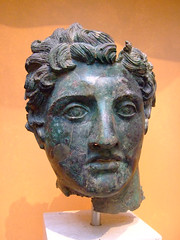
I think this is absolutely exciting! I have been fascinated by Alexander the Great since reading Mary Renault's trilogy, "Fire From Heaven", "The Persian Boy", and "Funeral Games". I found "The Persian Boy" by accident at an antique shop in a little eastern Oregon town and became mesmerized by the portrayal of Alexander in it. I researched the author and learned about her other works which I eagerly acquired. Later I studied the ancient biography of Alexander by Arrian and listened to an excellent Teaching Company Course, "Alexander the Great and the Hellenistic Age". Alexander was not without faults but was certainly a visionary and charismatic warrior. I've always wished that something of this amazing man would be found someday.
"An ancient Greek tomb thought to have held the body of Alexander the Great's father is actually that of Alexander's half brother, researchers say. This may mean that some of the artifacts found in the tomb—including a helmet, shield, and silver "crown"—originally belonged to Alexander the Great himself. Alexander's half brother is thought to have claimed these royal trappings after Alexander's death.
The tomb was one of three royal Macedonian burials excavated in 1977 by archaeologists working in the northern Greek village of Vergina.
Excavators at the time found richly appointed graves with artifacts including a unique silver headband, an iron helmet, and a ceremonial shield, along with a panoply of weapons and an object initially identified as a scepter.
"[Archaeologists] announced that the burial in the main chamber of the large rich [tomb] was that of Philip II, father of Alexander the Great, who was assassinated in 336 B.C," said Eugene N. Borza, professor emeritus of ancient history at Pennsylvania State University.
But recent analyses of the tombs and the paintings, pottery, and other artifacts found there, suggest that the burials are in fact one generation more recent than had previously been thought, Borza said.
Soon the duo realized the significance of the fact that Tomb II and Tomb III were built using a curved ceilings called barrel vaults.
"The earliest securely dated barrel vault in Greece dates to the late 320s [B.C.], nearly a generation after the death of Philip II," Borza told National Geographic News.
Palagia also found that paintings on the exterior frieze of the tomb reflected themes that were likely from the age of Alexander the Great, rather than that of his father.
The paintings depict a ritual hunt scene with Asian themes, suggesting influences resulting from Alexander's extensive campaigns to the east.
The six-foot (two-meter) scepter found at the burial site is another clue, Borza added."We have several surviving coins issued in his own lifetime showing Alexander holding what appears to be a scepter of about that height," he said.
Additionally, a number of silver vessels discovered in Tomb II and Tomb III are inscribed with their ancient weights, which use a measurement system introduced by Alexander the Great a generation after Philip II's death."
I just discovered your blog. You might be interested in mine in which I include some snippets of my novel "Shadow of the Lion" which is about the fall of Alexander's dynasty. Just getting ready to pitch it to publisher.
ReplyDeleteMy blog is http://wynnbexton.blogspot.com
I have been studying Alexander since the age of 16 and have travelled to many of the sites to do research etc.